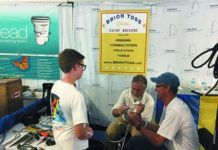During our 11 years of cruising and living aboard, my wife Theresa and I had a few close calls, but none involving the usual things many people worry about-no pirates, no survival storms, and no amorous whales. The most serious incidents involved something we too often take for granted: our health. The final installment of Practical Sailors four-part series on medical kits in this months issue (page 19) brought to mind one particularly scary incident.

Photo by Gaël Modrak
288
We were tucked behind a cape on the northeast corner of Flores Island in Indonesia. After two weeks of nearly windless sailing, we looked forward to a cool dip and the chance to plant our feet on the deserted coral beach beckoning 50 yards away. I grabbed my mask, jumped in to check the anchor, then swam toward shore. Theresa dove in a few seconds later. In my haste, I had not put on my water shoes, so I picked my way through the rocks on the way to shore. A few feet from the beach, I felt a sharp prick between my toes. Below the surface, I saw the demon, pectoral fins flared, teeth bared, venomous spines raised on its back. Instinctively acting in its own defense, the
scorpion fish had found its mark.
When I struggled back on the boat, my leg burned with pain. One of our medical books listed other symptoms I might expect: swelling, shortness of breath, seizure, paralysis…death. We were nearly 60 miles, or about 15 hours, by water from the nearest hospital in Maumere. Our only communication was a VHF radio, useless here.
Fortunately, the book also described treatment. After immersing my foot in near boiling water to neutralize the protein-based poison, the pain stopped at my upper thigh. The doctor in Maumere prescribed a course of antibiotics to prevent infection. Five days later, my foot was better, and we were much wiser.
There were other serious incidents, a skin infection in the Solomon Islands (me) and dengue fever in French Polynesia (Theresa), being the worst. Cruising friends had their own health problems: malaria (Vanuatu), intestinal parasites (Indonesia), ciguatera poisoning (French Polynesia), and rabies (vampire bats in Venezuela). This doesn’t include the range of ordinary health issues that cruisers face.
Fortunately, we live in an age when medical information, education, and equipment is readily available to the average cruiser. If you are planning to go long-term cruising, money spent on a good medical kit and the training to go with it is one of the best investments you can make.
Off the beaten track, a satellite phone and a subscription to a recognized telemedicine center is also money well spent. For the long-range cruiser, an ability to treat common onboard ailments and deal with medical emergencies is as important as an EPIRB or life raft-and far more likely to be put to use.
-Darrell Nicholson,
Editor



































